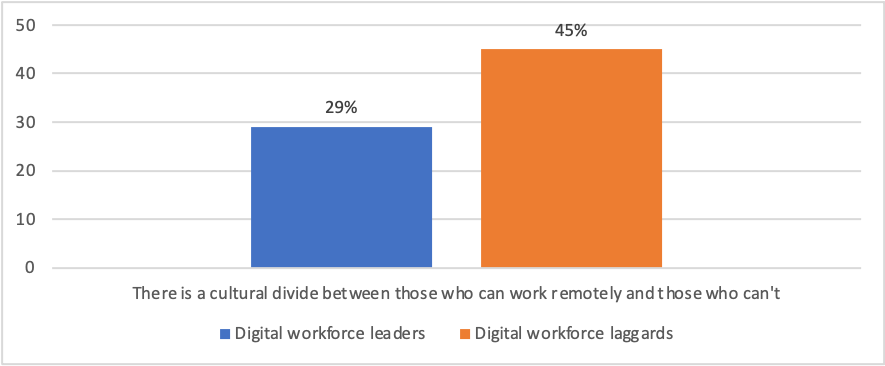The “Digital Workforce in 2021” survey ran in February and March, 2021. We gathered 284 usable complete and partial responses, primarily from HR professionals in virtually every industry vertical.
The survey was conducted by HR.com’s HR Research Institute in partnership with Accurate Background, a leading provider of compliant, background checks, drug and health screening and Form I-9 verifications.
Respondents to the survey were required to have operations in the U.S. but could be headquartered or have additional operations anywhere in the world.
The participants represent a broad cross-section of employers by number of employees, ranging from small businesses with fewer than 50 employees to enterprises with 20,000+ employees.
In this series of blog posts, we take a deep dive into our major findings based on this research and the implications for organizations now working in an increasingly digital environment.
Hybrid Companies Experiencing a Cultural Divide With Management Ill-Prepared to Address It
Major Finding Four: Organizations are struggling to effectively manage their remote workforces—37% say there is a cultural divide between those who can work remotely and those who can’t.
- Just 45% say that managers get the education and training needed to manage their remote workforces.
- More than half (56%) indicate employees are less likely to interact with coworkers outside of their teams.
- A surprising 60% are uncertain about how and when to bring current remote employees back to the physical workplace.
Return to work fraught with as many road bumps, if not more, as sending people home in 2020.
As the widespread availability of vaccinations to stem the spread of COVID-19 emerged in 2021, workforces around the country began calling employees back into their physical workspaces, but not without a certain amount of angst. Some employees aren’t yet comfortable enough to return to the workplace. Others, so-called “anti-vaxxers,” say they have no plans to receive the vaccination. Management staff aren’t immune to these issues—they, and their employees, may also be suffering from a certain amount of pandemic PTSD.
Employers and their HR leaders need to navigate these issues carefully and appropriately, recognizing that it’s likely they will be operating in a hybrid environment for some time. Yet, our research suggests that managers feel ill-prepared to manage in a hybrid environment where some employees are on-site while others are at home, and maintaining a strong and consistent culture is increasingly challenging.
Navigating the cultural divide between the “haves” and the “have nots.”
Some employees may want to come back to the workplace, but can’t because it’s not fully open for operations yet. Other organizations may be opening their offices to in-person work, but a certain segment of employees (and, yes, even managers) may be balking at re-entering the physical workspace.
Our research indicates a steep cultural divide between those who can work remotely and those who cannot.

This suggests that some companies may not be fully communicating why it is okay for some employees to work remotely while others can’t. For example, perhaps one manager allows their employees to work remotely while another manager with similar-situated employees doesn’t allow it. What are the protocols for this decision?
Of course, even with clear and fair protocols in place, some employees may still think everyone should have the flexibility to work remotely if a role allows for it and if an employee wishes to do so.
How to conquer the cultural divide.
In analyzing our data, we were able to segment respondents into two groups: digital workforce leaders and digital workforce laggards. Leaders are those who “strongly agree” and “agree” that their organization’s managers have the tools, technology, education, and training required to manage their remote workforce well.
Digital workforce leaders are strikingly more likely to indicate that their workplace cultures support a remote workforce (45%) when compared to digital workforce laggards (29%). The difference may relate to a lack of clear policies and procedures outlining when—and who—is eligible for remote work. The gap also may be related to managers’ own personal managerial preferences—e.g., digital workforce leaders may be more focused on achieving goals efficiently than valuing face time in the office.
When considering your workforce, it’s important to identify your managers’ feelings related to remote work. Does your organization have a leadership team that leads with collaboration and gives employees autonomy to do their jobs and support when they need it? Consider the extent that your organization values openness, collaboration, and teamwork and make a list of what characteristics or core values may need to change to allow for truly successful remote working arrangements and opportunities.
Think, also, about the policies in place—or new ones needed—to support your desired culture and clearly convey to employees what your expectations are. Here, while the policies themselves are certainly important, what’s even more important is how well, how often, and how consistently you communicate your policies and expectations to employees. In terms of a work-from-home policy, some important issues to consider include:
- What roles are, or are not, eligible for remote work consideration?
- Are there certain employee characteristics or attributes (e.g., achieving a certain rating on past performance reviews) that must exist to make an employee eligible?
- Do all employees need to be at the organization for 3 or 6 months before they can request online work, or are their exceptions such as when their previous role was remote?
- How will you ensure managers are not playing favorites and picking and choosing which employees will get remote opportunities?
Culture is critical in any organization, but becomes even more important in a hybrid environment where managers must be especially explicit about monitoring, managing, and nurturing a consistent corporate climate across all settings—on-site and off.
In our next post, we take a look at our fifth major finding: the pandemic has changed the way organizations hire.



